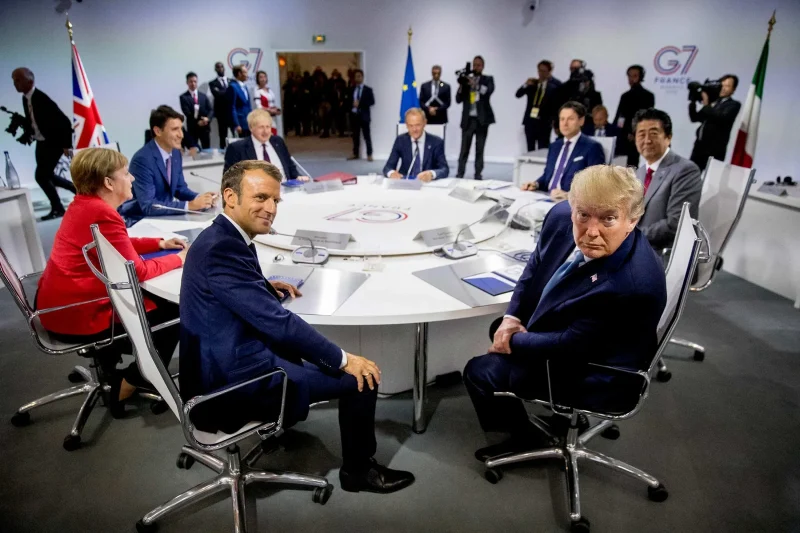G7 Leaders Agree to Disagree: The Annual Summit of Expensive Photos and Zero Results
The G7 Summit 2025 convened once again, bringing together the world’s most powerful leaders for a carefully choreographed display of diplomacy, press photo ops, and, as analysts from Bloomberg, Reuters, and The Economist note, remarkably little actionable policy. The summit, held in a five-star resort in the Italian Alps, cost taxpayers millions, yet discussions often conclude with the standard phrase: “We agree to disagree.” While the world watches, headlines fill with images of handshakes, smiling leaders, and perfectly staged panels , the modern-day ritual of international governance.
The Photo Op Economy
Photographers from Reuters and Getty Images were treated like royalty, capturing every handshake, conference room smile, and coffee cup tilt. Analysts note that these images serve multiple purposes: signaling unity, providing press material, and generating viral social media moments.
Traders on Wall Street joked that the summit’s photographic output alone could fuel a multi-million-dollar stock in “diplomacy optics futures.” The irony is not lost: expensive cameras and carefully curated moments overshadow actual agreements, creating a visual economy of perceived collaboration.
Summit Discussions: Substance Optional
Despite meticulous planning, substantive policy often takes a backseat. Analysts report that discussions on climate action, debt relief, and global economic coordination frequently conclude with ambiguous statements and broad commitments.
Delegates reiterate pledges to “explore solutions” and “consider frameworks,” leaving real-world outcomes delayed indefinitely. Analysts note that this pattern, repeated annually, underscores the ceremonial rather than operational nature of high-level summits.
The Press Conference Dance
Press conferences are carefully choreographed performances. Leaders deliver well-rehearsed lines, emphasizing consensus while sidestepping contentious issues. Analysts highlight the use of prepared talking points, friendly smiles, and strategic pauses to convey harmony despite underlying disagreements.
Journalists, armed with live-streaming tools and social media amplification, dissect every phrase for nuance, irony, or potential gaffes. Analysts suggest that the interplay between performative diplomacy and modern media creates a theatre in which perception often matters more than policy.
Economic Announcements: Numbers Without Action
G7 summits often include economic briefings and announcements, designed to signal intent rather than enforce change. Analysts note that statements on trade cooperation, carbon financing, and infrastructure investment frequently lack enforceable commitments or timelines.
Financial markets react to these announcements, with short-term volatility in equities, bonds, and commodities. Analysts observe that traders treat the summit as a “signal event,” adjusting positions based on perceived alignment or discord, even when actual policy remains undefined.
Climate and Global Policy Statements
Climate action discussions follow a familiar pattern. Leaders pledge reductions in emissions, investment in green technologies, and global cooperation. Analysts report that while these statements are symbolically important, the mechanisms for implementation often remain unspecified, creating a disconnect between promise and practice.
Non-governmental organizations and think tanks critique the lack of enforceable targets, noting that repeated annual commitments without concrete follow-through erode credibility. Analysts suggest that symbolism dominates over substance in shaping global environmental narratives.
Security and Geopolitical Coordination
Security and geopolitical issues, including international conflicts, trade disputes, and cyber threats, are frequently tabled. Analysts from The Economist note that consensus is difficult, given diverging national interests, regional priorities, and domestic political pressures.
The result is the standard communiqué emphasizing dialogue, collaboration, and the importance of continued discussions. Analysts highlight that while these statements foster diplomatic goodwill, tangible security outcomes are often deferred, leaving analysts and the public waiting for actionable results.
The Humor of Diplomacy
Wall Street traders, social media commentators, and satirical columnists have embraced the comedic elements of the summit. Analysts report jokes about “expensive photos with zero deliverables,” viral memes of leaders gesturing toward blank flipcharts, and humorous breakdowns of summit tweets.
Financial satire, analysts note, serves a dual purpose: it entertains and provides a lens for scrutinizing performative governance. Humor becomes a coping mechanism for public frustration with bureaucratic inertia while keeping scrutiny lighthearted yet insightful.
Public Perception and Media Amplification
Media coverage amplifies the ceremonial aspect of the summit. Analysts observe that international news outlets focus on images, soundbites, and viral moments, often at the expense of detailed policy analysis.
Social media platforms magnify every handshake, outfit choice, and offhand comment, creating a digital narrative that emphasizes spectacle over substance. Analysts suggest that public perception is shaped more by optics than by the effectiveness of agreements, reinforcing the performative culture of global summits.
Financial Market Response
Global markets, while analytically focused, respond to summit dynamics. Analysts report short-term movements in currency pairs, stock indices, and commodity prices based on perceived consensus or conflict among G7 leaders.
Ironically, market volatility often stems less from policy content and more from expectations and media framing. Traders jokingly refer to this as “G7 Whisper Trading,” where portfolios react to smiles and handshakes rather than enforceable economic measures.
Conclusion
The 2025 G7 Summit epitomizes the blend of ritual, spectacle, and strategic ambiguity in international diplomacy. Analysts agree that while symbolic gestures, photo ops, and ceremonial agreements have communicative value, tangible outcomes remain elusive.
Public, media, and market participants continue to engage with the summit as both a serious forum for global policy and a source of performative amusement. Analysts conclude that understanding the G7 requires appreciating the dual nature of modern summits: high-cost theater of collaboration accompanied by modest substantive achievements.
Despite repeated calls for enforceable commitments and measurable outcomes, the summit’s annual cycle ensures that Wall Street, media, and global observers return year after year, capturing photos, analyzing statements, and waiting for action that may never fully materialize. In 2025, the lesson remains clear: on Wall Street and beyond, optics often matter as much as policy.




